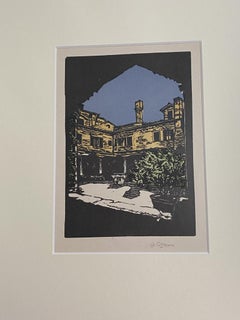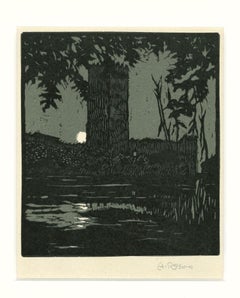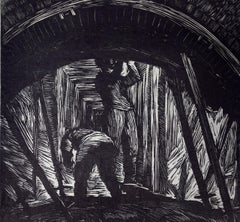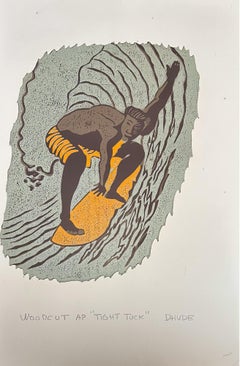Angelo Rossini Landscape Prints
to
2
Overall Width
to
Overall Height
to
2
179
169
145
131
2
2
1
1
1
1
1
1
1
2
2
Artist: Angelo Rossini
Lungotevere in Rome - Woodcut by A. Rossini - Early 20th Century
By Angelo Rossini
Located in Roma, IT
"Landscape" is an original xilograph on ivory-colored paper, realized by Angelo Rossini.
The state of preservation of the artwork is very good.
The signature of the Artist, on the ...
Category
Early 20th Century Angelo Rossini Landscape Prints
Materials
Woodcut
Lago di Ninfea - Woodcut by A. Rossini - Early 20th Century
By Angelo Rossini
Located in Roma, IT
"Lago di Ninfea" is an original woodcut print on ivory-colored paper, realized by Angelo Rossini.
The state of preservation of the artwork is very good.
The signature of the Artist...
Category
Early 20th Century Angelo Rossini Landscape Prints
Materials
Woodcut
Related Items
"Mine Shaft", Soviet Union: An Early 20th C. Woodcut Engraving by Abramovitz
By Albert Abramovitz
Located in Alamo, CA
This is a signed woodcut engraving entitled "Mine Shaft" created by Albert Abramovitz in 1935, after a trip to the Soviet Union. It depicts two Russian workers constructing a mine sh...
Category
1930s Angelo Rossini Landscape Prints
Materials
Woodcut
$1,175
H 13.38 in W 8.88 in
Tight Tuck - Surfing Art - Figurative - Woodcut Print By Marc Zimmerman
By Marc Zimmerman
Located in Carmel, CA
Tight Tuck - Surfing Art - Figurative - Woodcut Print By Marc Zimmerman
Limited Edition 01/04
This masterwork is exhibited in the Zimmerman Gallery, Carmel CA.
Immerse yourself in...
Category
2010s Contemporary Angelo Rossini Landscape Prints
Materials
Woodcut
Stevan Dohanos, Backyard
By Stevan Dohanos
Located in New York, NY
Stevan Dohanos was an accomplished draftsman who work was widely known through the Saturday Evening Post. This print 'Backyard,' however, leaves aside the illustrative magazine work ...
Category
1930s American Modern Angelo Rossini Landscape Prints
Materials
Woodcut
Modern American Industrial Landscape
Located in Buffalo, NY
An original woodblock print dated 1965, titled "Our Town" but signed illegibly.
Category
1960s American Modern Angelo Rossini Landscape Prints
Materials
Paper, Woodcut
Wahini #2 - Surfing Art - Figurative - Woodcut Print By Marc Zimmerman
By Marc Zimmerman
Located in Carmel, CA
Wahini #2 - Surfing Art - Figurative - Woodcut Print By Marc Zimmerman
Limited Edition 01/04
This masterwork is exhibited in the Zimmerman Gallery, Carmel CA.
Immerse yourself in ...
Category
2010s Contemporary Angelo Rossini Landscape Prints
Materials
Woodcut
Surf Elements - Surfing Art - Figurative - Woodcut Print By Marc Zimmerman
By Marc Zimmerman
Located in Carmel, CA
Surf Elements - Surfing Art - Figurative - Woodcut Print By Marc Zimmerman
Limited Edition 01/04
This masterwork is exhibited in the Zimmerman Gallery, Carmel CA.
Immerse yourself...
Category
2010s Contemporary Angelo Rossini Landscape Prints
Materials
Woodcut
Werner Drewes, Winter, 1933, modernist woodcut
By Werner Drewes
Located in New York, NY
A modernist fantasy winter scene created by Werner Drewes, this print brings key aspects of the period together. His cubist-inspired woodcut technique is utilized here to bring the s...
Category
1930s American Modern Angelo Rossini Landscape Prints
Materials
Woodcut
Joseph Zirker, Playhouse
By Joseph Zirker
Located in New York, NY
In the 1950s woodcuts started to get bigger and bigger as they competed with paintings for a space on the wall. This California print by Joseph Zirke...
Category
1950s American Modern Angelo Rossini Landscape Prints
Materials
Woodcut
"Skating on Ladies' Pond Central Park": Winslow Homer 19th C. Woodcut Engraving
By Winslow Homer
Located in Alamo, CA
This Winslow Homer woodcut engraving entitled "Skating on the Ladies' Skating-Pond in Central Park, New York", was published in Harper's Weekly in the January 28, 1860 edition. It depicts a large number of men, women and children skating on a recently opened pond in Central Park. At the time of publication of this engraving, Central Park was in the early stages of construction. This engraving documents the very early appearance of Frederick Law Olmstead and Calvert Vaux's masterpiece of landscape design. According to Olmsted, the park was "of great importance as the first real Park made in this century – a democratic development of the highest significance". The people of New York were very proud of the plans for their park. It was stated at the time: "Our Park, which is progressing very satisfactorily under the management of the Commissioners, will undoubtedly be, one of these days, one of the finest place of the kind in the world...Those who saw the Park before the engineers went to work on it are amazed at the beautiful sites which have been contrived with such unpromising materials; all fair persons believe that the enterprise is managed with honesty and good taste."
Skating was rapidly rising in national popularity in part due to the opening of Central Park’s lake to skaters on a Sunday in December 1858 with 300 participants. The following Sunday it attracted ten thousand skaters. By Christmas Day, a reported 50,000 people came to the park, most of them to skate. There were rules governing who could use the skating pond. “The Ladies’ Pond...
Category
1870s American Impressionist Angelo Rossini Landscape Prints
Materials
Engraving, Woodcut
$1,175
H 23.13 in W 29.5 in D 1.13 in
Ted Davies, El Station (New York City), woodcut
By Ted Davies
Located in New York, NY
In the 1950s woodcuts were getting bigger and bigger. This one isn't gigantic, but at an image size of 17 x 11 inches it is substantial. And of course NYC's El Trains and their stati...
Category
Mid-20th Century American Modern Angelo Rossini Landscape Prints
Materials
Woodcut
Oscar Weissbuch, Westchester Hills (NY), New Deal, WPA-era wood engraving
Located in New York, NY
New York City native Oscar Weissbuch (1904-1948), attended the Yale University School of Fine Arts and the Art Students League, NY. He participated in the NYC-WPA printmaking project...
Category
1930s American Modern Angelo Rossini Landscape Prints
Materials
Woodcut
Three Turns - Surfing Art By Marc Zimmerman
By Marc Zimmerman
Located in Carmel, CA
Three Turns - Surfing Art - Figurative - Woodcut Print By Marc Zimmerman
Limited Edition 01/04
This masterwork is exhibited in the Zimmerman Gallery, Carmel CA.
Immerse yourself i...
Category
2010s Contemporary Angelo Rossini Landscape Prints
Materials
Woodcut
Angelo Rossini landscape prints for sale on 1stDibs.
Find a wide variety of authentic Angelo Rossini landscape prints available for sale on 1stDibs. You can also browse by medium to find art by Angelo Rossini in woodcut print and more. Not every interior allows for large Angelo Rossini landscape prints, so small editions measuring 6 inches across are available. Angelo Rossini landscape prints prices can differ depending upon medium, time period and other attributes. On 1stDibs, the price for these items starts at $178 and tops out at $201, while the average work can sell for $189.



